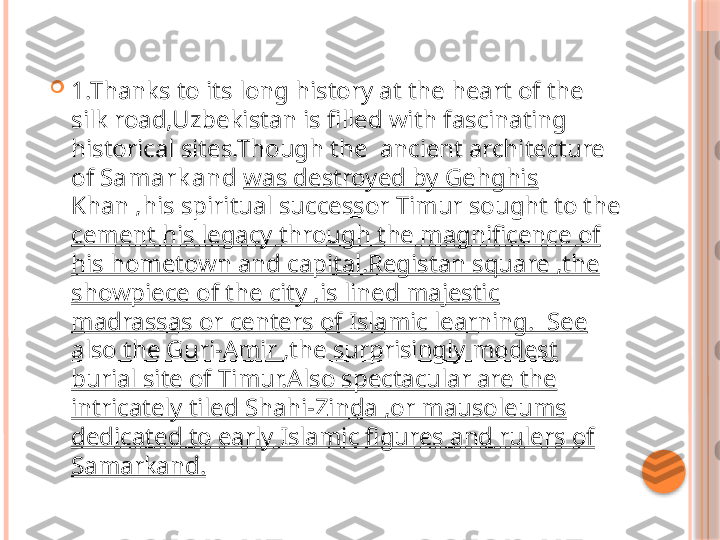HISTORICAL PLACES OF UZBEKISTAN.













HISTORICAL PLACES OF UZBEKISTAN.
QUESTIONS: 1. What do we see in Uzbekistan? 2. How do you get to Uzbekistan? 3. Which is the tallest Minaret in Uzbekistan? 4. What was this incomplete cilindyrc building supposed to be? 5. Which are Uzbekistan`s three greatest silk road cities? 6. In which city Tamerlane`s mausoleum located? 7. What do you know about Registan square? 8. Where is Khast-Imam square located? 9. What do you know about Ulugbeg’s observatory? 10. Which building was seemed to be Tamerlane`s palace?
1.Thanks to its long history at the heart of the silk road,Uzbekistan is filled with fascinating historical sites.Though the ancient architecture of Samark and was destroyed by Gehghis Khan ,his spiritual successor Timur sought to the cement his legacy through the magnificence of his hometown and capital.Registan square ,the showpiece of the city ,is lined majestic madrassas or centers of Islamic learning. See also the Guri-Amir ,the surprisingly modest burial site of Timur.Also spectacular are the intricately tiled Shahi-Zinda ,or mausoleums dedicated to early Islamic figures and rulers of Samarkand.
Nearby Buk hara ,also on the Silk road,is equally packed with historical sites.See the Ark , fortress built in the 5 th century and occupied until 1920, when it was bombed by the Red Army. It’s now mostly ruins, but the remaining royal quarters are home to several museums dedicated to Bukhara’s history . The 47 metre tall Kalon Minaret was built by Arslan Khan in 1127.It was the tallest building in Central Asia for centuries,and so impressed Genghis Khan that he ordered his men to preserve it,even as they ransacked the rest of the city.
The most atmospheric remnants of the Silk Road can be found in the walled city of Khiv a. Local laws provide that you can’t buy property in Khiva –land can only be passed down through the 3,000 families with ancestral claims. T his- along with its UNESCO world heritage status – means tha t the medieval city is well preserved.It’s easy to imagine the cosmopolitan traders of the silk road buying and selling camels , carpets, coffee beans , and the titular silk in the labyrinth of medieval streets,houses, and minarets.
